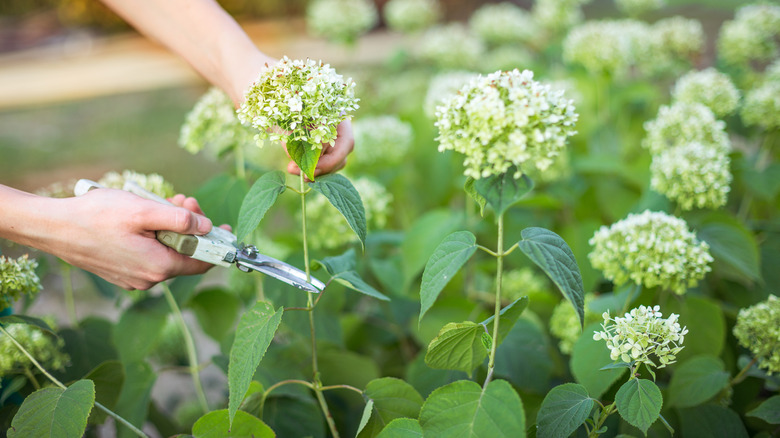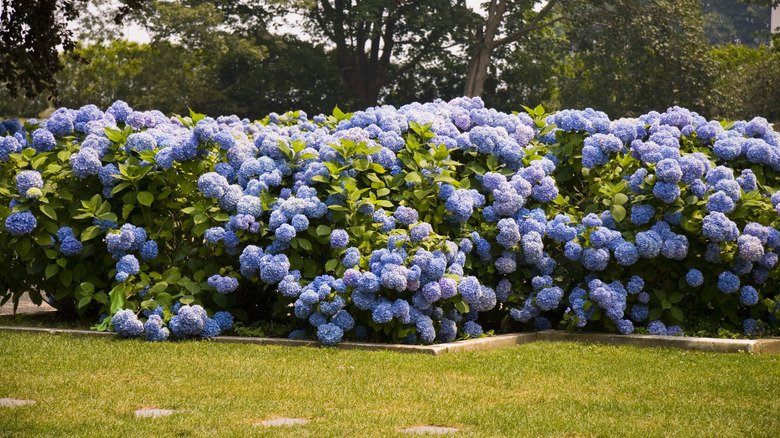Hydrangeas are some of the most popular flowering bushes, producing extremely large blooms that are easy to grow and take care of. Because they can grow extremely thick and can reach a height of several feet, they are among the best hedges you can plant in your yard to create a sense of privacy.
Additionally, they survive well when you plant several of them side by side in a mass planting, as long as they have plenty of space to flourish. A key factor to keep in mind when creating a hydrangea privacy hedge is proper pruning techniques. Some hydrangeas do not respond well to aggressive pruning, which may cause the plants to struggle to produce the blooms that you want to see. If choosing to prune to create a hedge shape, it’s important to not overdo it. Because of the risk of reducing blooms through pruning, some people allow them to grow wildly rather than cut them into a shape that resembles a traditional squared-off hedge. After all, the flowers are the most interesting part of these plants.
How to trim your hydrangea hedge

When creating a natural hedge with hydrangeas, you should focus more on pruning these plants in a way that keeps them healthy and that creates a basic shape of a hedge, rather than attempting to create the squared-off look that’s common with some natural bush hedges.
Some types of hydrangeas produce blooms on newly grown wood, like the smooth and panicle varieties. With these species, you should trim back the branches in late winter before the plants begin to actively grow. By mid-spring, the new branches should start to show buds before blooming in the summer. You then could start cutting back some of the new growth after the blooming occurs in the summer without affecting the ability of the hydrangea to produce blooms the following growing season. If you must prune after the buds begin appearing, only cut back to about an inch above the buds. Use an extremely sharp blade and cut it at a 45-degree angle to give the hydrangea the best chance of recovering fully.
For hydrangeas that produce blooms in the late summer on old wood, like bigleaf, oakleaf, and climbing varieties, avoid pruning new growth if at all possible. Instead, you should only cut these varieties to remove obviously dead branches once the bush begins to show leaves in the early spring.
How to plant a hydrangea hedge to minimize trimming needs

YouTube
One of the best ways to create a hydrangea hedge that needs minimal pruning is to plant it properly from the start. Allowing these bushes to grow to the proper height and to remain healthy should reduce the amount of pruning required.
Because hydrangeas grow about as tall as they are wide when they are fully mature, you need to plan for the full size of the shrubs when planting them. Even though it’s tempting to put them tight together to deliver overlapping growth faster for maximum privacy, do not plant them too close. If the shrubs are too close together, you will have limited airflow for the leaves, which could cause the shrub to not grow as healthy as it should.
Pay attention to the species of hydrangea you select for your hedge. A typical shrub will grow about 5 feet in height and width, so you should place them about 5 feet apart. If you want a bit of overlap, you can put them slightly closer than the suggested distance. Many hydrangeas grow quickly, up to 2 feet per year, which means you can have a full hedge within a few years. You may want to place a string along the ground and mark it with where to place it with individual hydrangea plants, so you can achieve the desired spacing. Don’t forget to account for growth outward, too.




